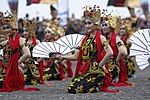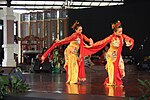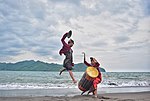Betawi mask dance
 Betawi mask dance performance | |
| Native name | Tari Topeng Betawi |
|---|---|
| Origin | Indonesia |
| Betawi mask dance |
|---|
|
| Burma |
| Cambodia |
|
| Indonesia |
|
| Laos |
|
| Malaysia |
| Philippines |
| Thailand |
| Vietnam |
The Betawi mask dance (Indonesian: Tari Topeng Betawi) is a theatrical form of dance-drama of Betawi people in Jakarta, Indonesia.[1] This dance-drama encompasses dance, music, bebodoran (comedy) and lakon (drama).[2] The Betawi mask dance demonstrates the theme of Betawi society life which represented in the form of dance and drama. It is called mask dance because the dancers using topeng (mask) during dancing which Betawi people believed that the topeng has magical powers.[3]
History and origin[]
The Betawi mask dance was first created by Mak Kinang and Kong Djioen in 1930 which was inspired by Cirebonese mask dance. This theatrical form of dance drama developed in the area of the Betawi Pinggir community (Betawi Ora) in Jakarta.[4]
Social functions[]
The Betawi mask dance has some social functions in Betawi society. In the past, Betawi people believed that Betawi mask dance has function to keep them away from dangers, diseases and calamities.[5] However, nowadays, Betawi occasions often performed the Betawi mask dance as a part of the occasion, such as in Betawi weddings, circumcisions and Lebaran.
Musical instruments[]
In the Betawi mask dance performance, musical instruments that usually played, includes rebab, gong, kendang, kempul, kulanter and kecrek.[6]
See also[]
References[]
- ^ "Tari Topeng Betawi Tarian Tradisional dari Jakarta". Negeriku Indonesia. Retrieved 6 November 2020.
- ^ ASEAN. "Traditional Betawi Mask Dance, Traditional Dance From Jakarta?". Indonesiar. Retrieved 6 November 2020.
- ^ "The Sacred Betawi Mask Dance". Indonesia Tourisme. Retrieved 6 November 2020.
- ^ PI, Redaksi. "Tari Topeng Betawi". Pariwisata Indonesia. Retrieved 6 November 2020.
- ^ "Topeng Betawi, Seni Tari". encyclopedia jakarta. Retrieved 6 November 2020.
- ^ "Topeng Betawi Dance". setubabakanbetawi. Retrieved 6 November 2020.
External links[]
- Dance in Indonesia
- Dances of Indonesia
- Dances of Java
- Theatre in Indonesia
- Traditional drama and theatre of Indonesia
- Masked dances
- Masquerade ceremonies in Asia







